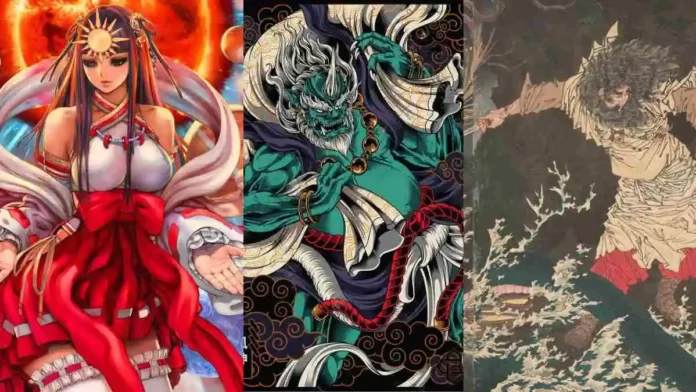
We are always curious about the mythologies around the world and keen to know about their origin, local accounts, and folklore. Most of us are aware of Egyptian or Greek mythology but mythology is a vast topic itself and each culture has its fair share of accounts and literary sources. Same like that, Japanese mythology is based on local folklore and beliefs. Let’s discuss Japanese mythology and its roots and origin.
The geography and topography of the region play a significant role in the creation of beliefs, and stories around the Japanese gods are no exception. Japanese mythology is highly based on the Shinto religion and some aspects of it are inspired by Buddhism.
The historical sources about Japanese history indicate the divine origin of their imperial line, which is an important aspect of Japanese mythology. Japanese mythology is passed through oral tradition by their ancestors to the next generation. Some good sources are Kojiki and Nihon Shoki. Kojiki means records of ancient matters. These two sources were written around the 6th or 7th century A.D.
Related: The Pantheon Of Egyptian Gods And Their Prominence In Ancient Egyptian Civilization
Japanese Gods And Goddesses
In Japanese mythology, gods and goddesses are called Kami. There are various Japanese kami, they have unique characteristics and features and they are defined according to their powers. Most of them are representations of natural forces. Some of them look like humans and some are depicted as half human and half creature.
Amaterasu
Amaterasu is known as the goddess of the sun in Japanese mythology. She is the daughter of Japanese creator deities. Japanese royal class claimed their descent from her. Amaterasu is amongst the main deity in the Shinto religion. She represents the rising sun, which is the representation of Japan itself and is considered the ruler of the universe. She is the queen of heaven and Kami.
She provides nourishment and energy to all living creatures and maintains the order of day and night. One most important beliefs in Shinto is that the sun is the representation of order and purity. Japanese noble classes claimed that the justice and order of Amaterasu were reflected in their rule because of their descendants from her. Ise Grand Shrine is dedicated to Amaterasu and is historically important in Japan.
Tsukuyomi
He is the moon god in Japan and also the husband of Amaterasu, the sun goddess. He is also the god of order and beauty. His father is Izanagi and his mother is Izanami, Susanoo and Amaterasu are his siblings. In local folklore, Tsukuyomi is regarded as a negative figure.
When Izanagi washed himself in a hot spring to purify, three Kami were born. Amaterasu was born from his left eye, Tsukuyomi from his right, and Susanoo from his nose. Izanagi made them the ruler of Heaven. He killed the Goddess of food, Uke Mochi in a feast hosted by her. He killed her because of her methods of food creation during the feast.
After this Amaterasu declared him unworthy of returning to Heaven, and this separation of them led to the origin of day and night. Tsukuyomi chased her across the sky forever after this separation.
Ame-no-Uzume
She is known as the Japanese goddess of dawn. She once saved the world from eternal darkness through her dancing, thus she is credited with the creation of performing arts. Ame-no-Uzume is also famous for her humor. Her name has many meanings, The Great Goddess, Great Persuader, etc.
She brings joy to the world and is considered a good servant to Amaterasu. Uzume’s husband is Sarutahiko Okami. She is always portrayed in Kyogen, a comedic theatre tradition. The theatre forms of kagura and Nob is related to her children. She appears in many tales pertaining to Amaterasu.
Also Read: “Naked, Hungry, And Trapped Alone” Nasubi Story Of The Worst Challenge In Reality Tv History
Benzaiten
She is the goddess of wisdom and luck and is considered the master of music, wealth, and time. She is also a Buddhist deity. She is one of the seven lucky gods and similar to the Indian goddess Sarasvati. Her name can be translated as the dispenser of wisdom and divine wealth.
The spread of Buddhism brought her to Japan and thus many different beliefs are associated with her in Japanese mythology. She is pictured with a Biwa, a type of musical instrument that is very much similar to the Indian Veena. Although Benzaiten has many similarities to other mythological deities, she has some unique local tales and is known as the daughter of the Dragon-King of Munetsuchi in Japanese folklore.
Bishamonten
He is a god of war and protector of shrines in Buddhism. He is the only god who is related to war and violence among the seven lucky gods. His name is translated as Guardian of heavenly gates which is very much similar to Lokpala in Vedic tradition. He is pictured with a spear in his hand. In the Buddhist tradition, his main role is as the guardian of the worshippers.
He carries a pagoda in another hand. He also came from the Indian subcontinent to Japan as he is the form of the Indian Buddhist deity Vaisravana, which is also derived from Vedic Sanskrit. He is also come with a role as a defender of Buddha, no matter wherever the Buddha preached. He is a key part of Buddhist and Shinto shrines.
Fujin
He is the powerful Japanese wind god and often appears alongside his brother Raijin, the thunder god. He is the ferocious force of nature and responsible for moving all the wind of the world. He is considered neither evil nor good. Fujin is translated as wind god. He is depicted as Oni (demon, devil) in Japanese folklore but is sometimes shown as Kami.
He is pictured with green skin and a fearful face. Many underworld demons are his siblings. Fujin is also a brother to Amaterasu and Tsukuyomi. When Izanagi left his wife Izanami in Yomi, the underworld blocked the entrance of it. Through a crack, many Oni escaped into the world to kill Izanagi. Fujin and Raijin are one of those Oni who escaped the underworld.
Raijin
He is the Japanese god of thunder, lightning, and storms. He brings chaos and destruction and is depicted alongside Fuji. He gives vital rain to the world. He is a popular Kami in local tales and stories of Japanese Mythology. He is pictured with a horrifying smile. He is related to the underworld, Yomi. He is the manifestation of the destructive force of nature.
Raijin is important for farmers as he brings down the rain to their farms. In Shinto and Buddhist traditions, he is labeled as a protector who gives both destruction and life to the land of Japan. Statues of Fujin and Raijin are built in a Buddhist temple as the protector of entrance in Kyoto, Japan. His son is Raitaro who is also believed as a thunder god in Japan.
Susanoo
He is the god of seas and thunder in Japan. He is the slayer of the eight-headed dragon, which he killed with his sword. He holds the authority over thunder, storm, lightning, and the sea. He is among the powerful trio of Kami who were born from the face of Izanagi. Susanoo is both kind and fearful in Japanese Mythology.
He is regarded as a hero figure in the folklore of Japan for the killing of the monster dragon. He is the master of the famous sword Kusanagi-no-Tsurugi also known as a grass cutter. He has many shrines are dedicated to him across Japan like Kumano Taisha, Susa shrine, and Hikawa shrine. Suasanoo was selected as the guardian figure of heaven by his father Izanagi. But due to his stormy nature, which is not good for the order of heaven Izanagi decided to expel his son from heaven and Susanoo accepted this.
Also Read: Eye Opening History of Roma Holocaust And Their Persecution During Nazi Regime



